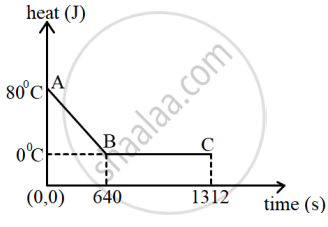Advertisements
Advertisements
प्रश्न
Derive Meyer’s relation for an ideal gas.
उत्तर
Meyer’s relation: Consider p mole of an ideal gas in a container with volume V, pressure P and temperature T.
When the gas is heated at constant volume the temperature increases by dT. As no work is done by the gas, the heat that flows into the system will increase only the internal energy. Let the change in internal energy be dU.
If Cv is the molar specific heat capacity at constant volume, from the equation.
`"C"_"v" = 1/µ "dU"/"dT"` ..........(1)
dU = µCvdT .........(2)
Suppose the gas is heated at constant pressure so that the temperature increases by dT. If ‘Q’ is the heat supplied in this process and ‘dV’ the change in volume of the gas.
Q = µCPdT …............(3)
If W is the work done by the gas in this process, then
W = PdV …................(4)
But from the first law of thermodynamics,
Q = dU + W …...............(5)
Substituting equations (2), (3) and (4) in (5), we get,
µCpdT = µCvdT + PdV
For mole of an ideal gas, the equation of state is given by
PV = µRT ⇒ PdV + VdP = µRdT
Since the pressure is constant, dP = 0
∴ CpdT = CvdT + RdT
∴ CP = Cv +R (or) Cp − Cv = R ......(6)
This relation is called Meyer’s relation It implies that the molar specific heat capacity of an ideal gas at constant pressure is greater than molar specific heat capacity at constant volume. The relation shows that specific heat at constant pressure (sp) is always greater than specific heat at constant volume (sv).
APPEARS IN
संबंधित प्रश्न
A child running a temperature of 101°F is given an antipyrin (i.e. a medicine that lowers fever) which causes an increase in the rate of evaporation of sweat from his body. If the fever is brought down to 98 °F in 20 min, what is the average rate of extra evaporation caused, by the drug? Assume the evaporation mechanism to be the only way by which heat is lost. The mass of the child is 30 kg. The specific heat of human body is approximately the same as that of water, and latent heat of evaporation of water at that temperature is about 580 cal g–1.
A mass m1 of a substance of specific heat capacity c1 at temperature t1 is mixed with a mass m2 of other substance of specific heat capacity c2 at a lower temperature t2. Deduce the expression for the temperature t of the mixture. State the assumption made, if any.
Ice cream appears colder to the mouth than water at 0℃. Give reason.
How will climate changes affect the various animal species?
Without green house effect, the average temperature of earth’s surface would have been:
(a) – 18℃
(b) 33℃
(c) 0℃
(d) 15℃
State, with reason, which of the two, boiling water or steam both at 100°C will produce more severe burns.
State factors on which the amount of heat radiated by a body depends.
The diagram below shows a cooling curve for 200 g of water. The heat is extracted at the rate of 100 Js-1. Answer the questions that follow:

- Calculate specific heat capacity of water.
- Heat released in the region BC.
When two kilocalories of heat are supplied to a system, the internal energy of the system increases by 5030 J and the work done by the gas against the external pressure is 3350 J. Calculate J, the mechanical equivalent of heat.
Specific heat capacity of a substance X is 1900 Jkg-1°C-1 means ______.
